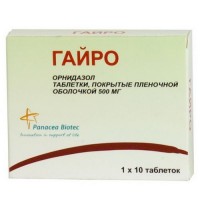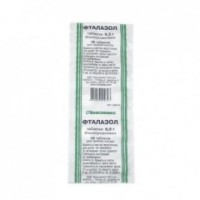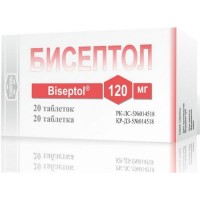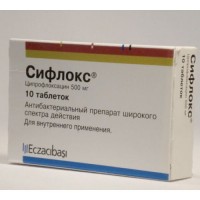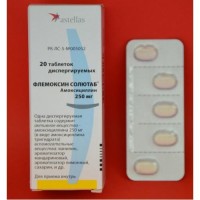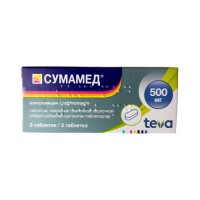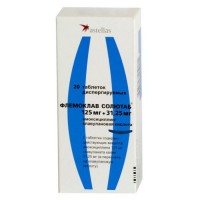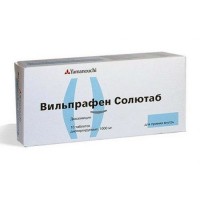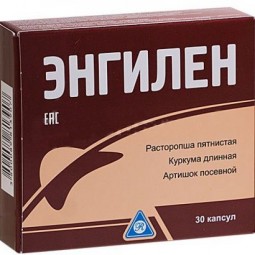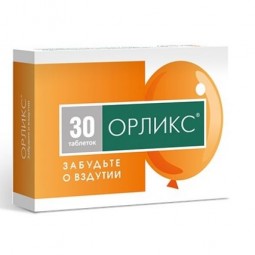The instruction on medical the Trade name of Tsipromet Mezhdunarodnoye the unlicensed name Is not present primeneniyulekarstvenny means of Tsipromet the Dosage form of the Tablet Structure One Tablet contains active agents: ciprofloxacin of a hydrochloride of 580 mg, corresponds to ciprofloxacin of BP of 500 mg, metronidazole of 200 mg, excipients: lactose, starch, magnesium stearate. The description of the Tablet of an oval form of white or almost white color, biconvex with risky on one party Pharmacotherapeutic group Antibacterial drugs for system use. Combination of antimicrobial drugs. The ATC J01R code the Pharmacological Pharmacokinetics Ciprofloxacin properties is well soaked up after intake. At the same time its bioavailability fluctuates from 69% to 85%. Food significantly does not influence absorption (does not change Cmax and bioavailability), however the antacids containing aluminum and/or magnesium reduce its absorption after oral administration. At oral appointment the maximum serumal concentration are reached in 1-1.5 hours. Has linear dependence on size of the accepted dose and makes at doses 250, 500, 750 and 1000 mg - 1.2, 2.4, 4.3 and 5.4 mkg/ml, respectively. The received levels are much higher than the minimum overwhelming concentration (MOC). In 12 h after intake of 250, 500 or 750 mg the concentration of drug in plasma decreases to 0.1, 0.2 and 0.4 mkg/ml, respectively. Distribution volume - 2-3.5 l/kg. Linking with proteins makes from 20% to 40%. Ciprofloxacin is extensively distributed on all tissues of a body (excepting the fabric rich with fats. In the central nervous system (CNS) ciprofloxacin does not reach therapeutic concentration). Well concentrates in various fabrics. Its content in many fabrics exceeds the content in blood (2-12 times higher, than in plasma). Therapeutic concentration are reached in saliva, tonsils, a liver, a gall bladder, bile, intestines, abdominal organs and a small pelvis, a uterus, semen, prostate tissue, endometrium, fallopian pipes and ovaries, kidneys and urinary bodies, pulmonary fabric, a bronchial secret, a bone tissue, muscles, synovial fluid and articulate cartilages, peritoneal liquid, skin. Ciprofloxacin also well gets into eye liquid, a lymph. Concentration of ciprofloxacin in neutrophils of blood is 2-7 times higher, than in serum. In comparison with any other antibacterial drugs ciprofloxacin reaches the highest concentrations in bones in osteomyelitis. Concentration in various fabrics and liquids of an organism are very high in comparison to extremely low MPK for the majority of activators. Gets into the medullispinal liquid (ML) in number of 6-37%. The activity decreases at acid values of the environment (rn) a little. Ciprofloxacin is exposed only partial (10-20%) to metabolism in a liver with formation of the metabolites keeping some activity. T1/2 - about 4 h at an oral way introduction. It is brought out of an organism generally in not changed look, the most part is removed by kidneys by tubular filtration and canalicular secretion in not changed look (40-50%) and in the form of metabolites (15%), the rest - through the digestive tract (DT) with bile and a stake. Renal clearance - 3-5 ml/min., the general clearance - 8-10 ml/min. In a renal failure (the clearance of creatinine (CC) is higher than 20 ml/min.) the percent of the drug removed through kidneys decreases, but cumulation in an organism does not happen owing to compensatory increase in metabolism of drug and removal with stool. Patients with a heavy renal failure (KK is lower than 20 ml/min. / 1.73 of sq.m) need to appoint a half of a daily dose. Therapeutic concentration (biologically active period) are maintained for 10-12 hours, and in urine - till 24 o'clock. Big elimination half-life in combination with post-antibiotic effect only two times a day orally allow to appoint ciprofloxacin. Metronidazole after intake quickly and almost is completely soaked up. Meal does not influence drug absorption. Plasma concentration of metronidazole are proportional to the entered dose. The maximum plasma concentration of 5-10 mkg/ml note in an hour after introduction of a single dose 250 and 500 mg. Metronidazole quickly gets into fabrics (lungs, kidneys, a liver, skin, bile, cerebrospinal fluid, saliva, a vaginal secret, semen and into breast milk), passes through a placental barrier. Distribution volume: adult - about 0.55 l/kg, newborn – 0.54-0.81 l/kg. Concentration of metronidazole and its metabolites in blood plasma of the child make 10-20% of concentration in mother's blood. Metabolism is carried out in a liver. In an organism about 30-60% of metronidazole by hydroxylation, oxidation and a glyukuronirovaniye are metabolized. The main metabolite (2 oxymetronidazole) also has antiprotozoan and antimicrobial effect. Elimination half-life of T 1/2 at normal function of a liver - 8 h (from 6 to 12 h), at alcoholic damage of a liver - 18 h (from 10 to 29 h), at the newborns who were born at the duration of gestation of 28-30 weeks - about 75 h, respectively, 32-35 weeks - 35 h, 36-40 weeks - 25 h. Communication with blood proteins insignificant also does not exceed 8-10%. It is removed by kidneys of 60-80% (20% in not changed look), through intestines - 6-15%. Renal clearance – 10.2 ml/min. At patients with a renal failure after repeated introduction the metronidazole kumulirovaniye in blood serum can be observed therefore at patients with a heavy renal failure the frequency of reception should be reduced. The pharmacodynamics Ciprofloxacin possesses a wide range of antimicrobial action at extremely low MPK (from 0.01 to 2 mg/ml), is most active concerning gram-negative bacteria, influence on anaerobe bacterias is less significant. Has effect on Enterococcus faecalis, Staphylococcus aureus, Staphylococcus epidermidis, Streptococcus pneumoniae, Streptococcus pyogenes, Campylobacter jejuni, Citrobacter diversus, Citrobacter freundii, Enterobacter cloacaae, Escherichia coli, Haemophilus influenzae, Haemophilus parainfluenzae, Klebsiella pneumoniae, Morganella morganii, Neisseria gonorrhoeae, Proteus mirabilis, Proteus vulgaris, Providencia rettgeri, Providencia stuartii, Pseudomonas aeruginosa, Salmonella typhi, Serratia marcescens, Shigella flexneri, Shigella sonnei, Staphylococcus haemolyticus, Staphylococcus hominis, Staphylococcus saprophyticus, Acinetobacter spp., Acinetobacter calcoaceticus, Aeromonas caviae, Aeromonas hydrophilia, Brucella melitensis, Campylobacter coli, Edwardsiella tarda, Enterobacter aerogenes, Haemophilus ducreyi, Klebsiella oxytoca, Legionella pneumophila, Moraxella (Branhamella) catarrhalis, Neisseria meningitidis, Pasteurella multocida, Salmonella enteritidis, Vibrio cholerae, Vibrio parahaemolyticus, Vibrio vulnificus, Yersinia enterocolitica, Chlamydia trachomatis, Mycobacterium tuberculosis. In acidic environment the activity decreases. The resistance develops slowly and gradually (multistage type). It is active concerning many strains of the stafilokokk (which are producing and not producing penicillinase metitsillinrezistentny), some types of enterococci and also a kampilobakter, legionell, mycoplasmas, chlamydias, mycobacteria. However the majority of the stafilokokk resistant to Methicillinum are resistant also to ciprofloxacin. It is active also concerning the activators resistant to laktamny antibiotics (producing beta lactamelements), to aminoglycosides, tetracyclines. Sensitivity of bacteria of Streptococcus pneumoniae, Enterococcus faecalis moderate. To drug of a rezistentna Corynebacterium spp., Bacteroides fragilis, Pseudomonas cepacia, Pseudomonas maltophilia, Ureaplasma urealyticum, Clostridium difficile, Nocardia asteroides. Has no overwhelming effect on anaerobe bacterias who make the main part of normal indestinal flora, and therapeutic action on viruses, mushrooms, the elementary. It is not effective concerning Treponema pallidum. Ciprofloxacin has the double mechanism of action that does it is more powerful than other antibiotics. 1. Total block DNK-girazy: inhibits both subunits DNK-girazy, superspiralizuyushchy sites of chromosomal molecules DNA (it is necessary for reading of genetic information), breaks DNA biosynthesis, growth and division of bacteria. Effect of ciprofloxacin (unlike other ftorkhinolon) is not inhibited by rifampicin or chloramphenicol. It can be effective against the bacteria resistant to other ftorkhinolona. 2. Causes the significant morphological changes (destroys a cell wall and membranes of bacteria) and fast death of a bacterial cell that enhances its bactericidal activity. Existence in structure of ciprofloxacin of a cyclopropyl ring provides activity of drug concerning almost all aerobic bacteria and also bioavailability in all fabrics (except for the central nervous system). Metronidazole - antiprotozoan and antimicrobial drug, derivative 5 nitroimidazoles. The mechanism of action consists in biochemical restoration 5 nitrogroups of intracellular transport proteins of anaerobic microorganisms and protozoa. The restored 5 nitrogroup interacts with DNA of a cell of microorganisms, inhibiting synthesis of their nucleic acids that leads to death of bacteria. Entamoeba histolytica, Gardnerella vaginalis, Giardia intestinalis, Lamblia spp. and also strict anaerobes of Bacteroides spp is active concerning Trichomonas vaginalis. (including Bacteroides fragilis, Bacteroides distasonis, Bacteroides ovatus, Bacteroides thetaiotaomicron, Bacteroides vulgatis), Fusobacterium spp., Veilonella spp., Prevotella (P. bivia, P. buccae, P. disiens), and some gram-positive microorganisms (Eubacterium spp., Clostridium spp., Peptococcus spp., Peptostreptococcus spp.). MPK for these strains makes 0.125-6.25 mkg/ml. Some aerobic gram-negative microorganisms are sensitive to metronidazole (a helikobakter, a gardnerella). Metronidazole gets into breast milk. Prescribing of metronidazole to the persons having alcoholism leads to forming at them of disgust for alcohol (antabusopodobny reaction). Indications - the respiratory infections which are especially caused by Klebsiella, Enterobacter, Proteus, Pseudomonas, Legionella, Staphylococcus, E.coli (an acute bronchitis and aggravation chronic, pneumonia, including intrahospital (except pneumococcal), the bronchial pneumonia, a bronchoectatic disease infected bronchiectasias, infectious pleurisy, an empyema, abscess of a lung and pulmonary infections at patients with a mucoviscidosis) - infections of bodies of a small pelvis, an urinogenital system, kidneys and urinary tract (cystitis, pyelonephritis, prostatitis, an adnexitis, a salpingitis, an oophoritis, an endometritis, tubular abscess, an epididymite, pelvic peritonitis, the chronic, complicated, repeated and recurrent infections of urinary tract), the infections caused by types of Bacteroides, including the fragilis group B., types of Clostridium, Peptococcus and Peptostreptococcus of an infection of an abdominal cavity (peritonitis, liver abscess) - venereal diseases (gonorrhea, including urethral, rectal and pharyngeal gonococcal infections and also caused by steady gonokokka), a venereal ulcer, clamidiosis, gonorrhea with the accompanying trichomoniasis - infections of an abdominal cavity and digestive tract (a gall bladder and biliary tract, intraperitoneal abscesses, peritonitis, salmonellosis, including. typhoid, campylobacteriosis, iyersinioz, a shigellosis, cholera, bacterial diarrheas, the pseudomembranous colitis connected with use of antibiotics) - infections of bones and joints (osteomyelitis, septic arthritis) - infectious and inflammatory diseases of ENT organs - prevention of postoperative complications (especially interventions on a colon, near-rectal area, appendectomy, gynecologic operations) - sepsis, a septicaemia, bacteremia - prevention and treatment of infections at patients with reduced immunity, including, against the background of treatment by immunodepressants and at a neutropenia - prevention of infections at surgical interventions - for selective decontamination of intestines. The route of administration and doses define Tsipromet's Dose on the basis of weight of an infection, a species of microorganism and age, body weight and function of kidneys of the patient. - slight infections of lower parts of airways – 1/2 moderately severe tablets and heavy – 1 tablet each 12 hours. The dose in 1.5 tablets has to be applied each 12 hours in cases of the infections caused by moderately sensitive streptococci - uncomplicated infections of urinary tract: 1/2 tablets each 12 hours - prostatitis and the complicated infections of urinary tract at patients with expressed by the subject structural anomalies: 1 tablet each 12 hours - infections of ENT organs 1-1.5 tablets each 12 hours - infections of bones and joints 1-1.5 tablets each 12 hours - infections of an abdominal cavity and digestive tract 1/2-1 tablet each 12 hours - a typhoid 1-1.5 tablets each 12 hours within 10 days - gynecologic infections 1 tablet each 12 hours - prevention of postoperative complications (especially interventions on a colon, near-rectal area, appendectomy, gynecologic operations) 1 tablet each 12 hours 7 days - gonorrhea with the accompanying trichomoniasis 1 tablet each 12 hours - a septicaemia, bacteremia and intraabdominal infections: initially - in/in therapy by ciprofloxacin and metronidazole then it is possible to pass to Tsipromet's reception inside 1-1.5 tablets each 12 hours - prevention and treatment of infections at patients with reduced immunity, including, against the background of treatment by immunodepressants and at a neutropenia: 1 tablet each 12 hours At patients with a heavy renal failure (with clearance of creatinine it is less than 20 ml/min.) a total daily dose should be reduced twice. If necessary it is possible to increase an oral dose to 2 tablets 2 times a day. Tsipromet can appoint irrespective of meal. However for achievement of the best bioavailability it is more preferable to accept it next the heart, without chewing in 2 hours after a meal. It is necessary to avoid a concomitant use of antacids, the sukralfat and iron preparations. Against the background of treatment by Tsipromet sick the increased liquid consumption is necessary. Duration of treatment depends on weight of an infection, clinical reaction and bacteriological data. Usually duration of therapy of acute infections is from 5 to 14 days, in infections of bones and joints the course of treatment can be prolonged up to 4-6 weeks. In general, it is necessary to continue treatment not less than 2-3 days after disappearance of symptoms of an infection. Side effects - nausea, vomiting, an abdominal pain, diarrhea - a headache, dizziness, concern, change of mood, confusion of consciousness, sleep disorder, a tremor, disorder of vision, taste, sense of smell, sonitus, spasms, dizziness, an incoordination of movements, an ataxy, a dysarthtia, a depression, peripheral neuropathy, drowsiness, teturamopodobny effect. - tachycardia, arrhythmia, a faint, decrease in a tooth of T on the ECG - thrombosis of cerebral arteries, increase in intracranial pressure - articulate pains, muscular pains, a tendovaginitis, ruptures of sinews (at co-administration with glucocorticoids) - increase in serumal transaminases, a prothrombinopenia, a hyperglycemia - skin rash, a skin itching, a small tortoiseshell, petechias, medicinal fever - a photosensitization, a face edema and throats, short wind - dysbacteriosis, candidiasis - a loss of appetite, metal smack in a mouth, dryness in a mouth, nausea, vomiting, diarrhea, an abdominal pain, a meteorism, pancreatitis, cholestatic jaundice, hepatitis, a glossitis, stomatitis, - a reversible leukopenia (neutropenia) and reversible thrombocytopenia, anemia, an eosinophilia, a leukocytosis, a thrombocytosis - a dysuria, a polyuria, darkening of color, a proteinuria, a hamaturia, a crystalluria, an ischuria, interstitial nephrite, a glomerulonephritis - a vasculitis, pseudomembranous colitis, anaphylactic reactions, Stephens-Johnson's syndrome and a Lyell's disease, - an epiphora (the watering eyes) - arthralgias, arthritis, a tendovaginitis, ruptures of sinews, an asthenia, myalgia. These reactions are more often observed at prolonged use of high doses and regress at the treatment termination. Contraindications - hypersensitivity to metronidazole, ciprofloxacin or any other derivative ftorkhinolon
(or instructions on it in the anamnesis) - organic lesions of central nervous system - a blood disease, a leukopenia (including in the anamnesis) - a sharp porphyria - pregnancy and a lactation - children's and teenage age up to 18 years - deficit glyukozo-6-fosfatdegidrogenazy - a renal/liver failure. Medicinal interactions of Tsipromet, the content of chlorides reduces and increases level in plasma of caffeine, Aminophyllinum. Tsipromet in combination with theophylline can lead to increase in concentration of the last in blood. Tsipromet in combination with cyclosporine quickly leads to increase in concentration of cyclosporine (increase in its nephrotoxicity) and creatinine level in blood serum. Sukralfat, the bismuth drugs, antacids containing ions of aluminum, magnesium or calcium, Cimetidinum, ranitidine, vitamins C microelements, gland sulfate, zinc, didanozin depletive reduces Tsipromet's absorption, its concentration in serum and urine therefore time interval between prescribing of these drugs has to be not less than 2 - 4 hours. Tsipromet in combination with non-steroidal anti-inflammatory drugs (NPVS) can cause increase in excitability of central nervous system and a spasm. Tsipromet enhances effect of oral anticoagulants (extends a bleeding time). At simultaneous use of Tsipromet and warfarin strengthening of action of the last is possible. Probenetsid, azlotsillin increase concentration in Tsiprometa blood. Simultaneous use of Tsipromet with glibenclamide can strengthen action of the last. The drugs alkalinizing urine (citrates, sodium bicarbonate, karboangidraza inhibitors) reduce Tsipromet's solubility. At a combination to a beta laktamnymi antibiotics, aminoglycosides, Vancomycinum, clindamycin, erythromycin Tsipromet's activity increases. At Tsipromet's combination with bacteriostatic antibiotics and nitrofurans the emergence of antagonism between drugs is possible. Under the influence of barbiturates the decrease in effect of Tsipromet as the inactivation of the metronidazole which is Tsipromet's part in a liver accelerates is possible. At combined use of Tsipromet and alcohol owing to blockade by metronidazole of enzyme of an aldegiddegidrogenaza face reddening, vomiting, an abdominal pain is possible. It is not necessary to combine Tsipromet with Teturamum as in interaction of these drugs the consciousness oppression, psychotic disorders is possible. Simultaneous introduction with neurotoxic drugs can cause complications of the same orientation. Adsorbents, holestiramin, the knitting and enveloping means reduce Tsipromet's absorption in digestive tract. In a combination with amoxicillin shows activity concerning Helicobacter pylori. Ukazaniyatsipromt special can stimulate central nervous system. The patient with epilepsy, attacks of spasms in the anamnesis, vascular diseases and an organic brain damage (heavy cerebral atherosclerosis) it is necessary to appoint Tsipromet according to vital indications. With care appoint at advanced age (control of concentration in blood plasma is necessary). In these cases the reduction of a dose of drug depending on disease severity is recommended. Against the background of therapy by Tsipromet the change of some laboratory indicators is possible: emergence of a deposit in urine, temporary increase in concentration of urea, creatinine, bilirubin, hepatic transaminases in serum, in some cases - a hyperglycemia, a crystalluria, a hamaturia, change of indicators of a prothrombin. Emergence of dark coloring of urine has no clinical value. For prevention of a crystalluria the patients receiving Tsipromet have to receive enough liquid. It is necessary to avoid excess alkalization of urine. It is impossible to exceed the recommended daily dose. In the course of treatment the control of concentration in blood of urea, creatinine, hepatic transaminases is necessary. At patients with a renal failure the dose needs to be reduced. At emergence in time or after treatment of heavy and long diarrhea it is necessary to exclude the diagnosis of pseudomembranous colitis which demands immediate drug withdrawal and purpose of the corresponding treatment. At appearance of pains in sinews or at emergence of the first symptoms of a tendovaginitis the treatment should be stopped (separate cases of inflammation and even a rupture of sinews are described during treatment of a ftorkhinolonama). During treatment it is necessary to avoid contact with direct sunshine, it is impossible to appoint the physiotherapy connected with UF-influence. It is necessary to warn patients about the sparing insolation mode within 5-7 days after drug withdrawal. At the lowered function of a liver there is metronidazole cumulation that demands Tsipromet dose decline. During a course of treatment and within three days after a shock dose (at treatment of gonorrhea with trichomoniasis) consumption of alcoholic drinks is strictly forbidden (risk of development of disulfiramopodobny reactions against the background of metronidazole). During use of drug the slight leukopenia and a neutropenia therefore at 7-10 day courses of treatment it is necessary to control a blood pattern (quantity of leukocytes), especially when it is necessary to repeat a therapy course (can be observed in trichomoniasis, an amebiasis). It is necessary to apply with care at hemopoiesis disturbances as at initial disturbances of a hemopoiesis the risk of development of a leukopenia and neutropenia increases. At long prescribing of drug the pattern of blood should be controlled monthly. Tsipromet can cause dryness in a mouth and flavoring disturbances. The dryness in a mouth contributes to the development of caries, diseases of peridental fabrics and candidiasis of an oral cavity. At treatment by Tsipromet the overdevelopment of fungal flora of a vagina is sometimes observed that demands the accompanying treatment by antifungal drugs. Pregnancy and a lactation Use during pregnancy is not recommended. During administration of drug the breastfeeding is stopped. The feature of influence of medicine on ability to run the vehicle or potentially dangerous mechanisms At treatment by Tsipromet to patients should limit the activity connected with need of fast concentration of attention and high reactionary ability. Overdose the following symptoms Can be observed: nausea, vomiting, an ataxy, in hard cases - peripheral neuropathy and epileptic seizures. Treatment: gastric lavage, introduction of a large amount of liquid, creation of acid reaction of urine, in addition - a hemodialysis and peritoneal dialysis (at perinetonealny dialysis, metronidazole is removed in insignificant quantities). All events are held against the background of maintenance of functions of vitals. Drug has no specific antidotes. The form of release and packing of Tablet No. 10 in blister strip packaging place in a cardboard pack with the instruction for medical use the state and Russian languages. Storage conditions In the dry place protected from light at a temperature not higher than 25 wasps. To store out of children's reach! 3 years After an expiration date not to apply an expiration date. Prescription status According to the prescription the Producer Kwality Pharmaceuticals PVT Ltd. India, Denovo Impex LLP, the Republic of Kazakhstan the Owner of the registration certificate of Denovo Impex LLP, Kazakhstan the Address of the organization accepting in the territory of the Republic of Kazakhstan claims from consumers on quality of products (goods) is packed: Republic of Kazakhstan, Almaty, Utegen St. of the batyr, 13 Ph.: (7272) 771998 E-mail:
To Develop denovokz@rambler.ru
(or instructions on it in the anamnesis) - organic lesions of central nervous system - a blood disease, a leukopenia (including in the anamnesis) - a sharp porphyria - pregnancy and a lactation - children's and teenage age up to 18 years - deficit glyukozo-6-fosfatdegidrogenazy - a renal/liver failure. Medicinal interactions of Tsipromet, the content of chlorides reduces and increases level in plasma of caffeine, Aminophyllinum. Tsipromet in combination with theophylline can lead to increase in concentration of the last in blood. Tsipromet in combination with cyclosporine quickly leads to increase in concentration of cyclosporine (increase in its nephrotoxicity) and creatinine level in blood serum. Sukralfat, the bismuth drugs, antacids containing ions of aluminum, magnesium or calcium, Cimetidinum, ranitidine, vitamins C microelements, gland sulfate, zinc, didanozin depletive reduces Tsipromet's absorption, its concentration in serum and urine therefore time interval between prescribing of these drugs has to be not less than 2 - 4 hours. Tsipromet in combination with non-steroidal anti-inflammatory drugs (NPVS) can cause increase in excitability of central nervous system and a spasm. Tsipromet enhances effect of oral anticoagulants (extends a bleeding time). At simultaneous use of Tsipromet and warfarin strengthening of action of the last is possible. Probenetsid, azlotsillin increase concentration in Tsiprometa blood. Simultaneous use of Tsipromet with glibenclamide can strengthen action of the last. The drugs alkalinizing urine (citrates, sodium bicarbonate, karboangidraza inhibitors) reduce Tsipromet's solubility. At a combination to a beta laktamnymi antibiotics, aminoglycosides, Vancomycinum, clindamycin, erythromycin Tsipromet's activity increases. At Tsipromet's combination with bacteriostatic antibiotics and nitrofurans the emergence of antagonism between drugs is possible. Under the influence of barbiturates the decrease in effect of Tsipromet as the inactivation of the metronidazole which is Tsipromet's part in a liver accelerates is possible. At combined use of Tsipromet and alcohol owing to blockade by metronidazole of enzyme of an aldegiddegidrogenaza face reddening, vomiting, an abdominal pain is possible. It is not necessary to combine Tsipromet with Teturamum as in interaction of these drugs the consciousness oppression, psychotic disorders is possible. Simultaneous introduction with neurotoxic drugs can cause complications of the same orientation. Adsorbents, holestiramin, the knitting and enveloping means reduce Tsipromet's absorption in digestive tract. In a combination with amoxicillin shows activity concerning Helicobacter pylori. Ukazaniyatsipromt special can stimulate central nervous system. The patient with epilepsy, attacks of spasms in the anamnesis, vascular diseases and an organic brain damage (heavy cerebral atherosclerosis) it is necessary to appoint Tsipromet according to vital indications. With care appoint at advanced age (control of concentration in blood plasma is necessary). In these cases the reduction of a dose of drug depending on disease severity is recommended. Against the background of therapy by Tsipromet the change of some laboratory indicators is possible: emergence of a deposit in urine, temporary increase in concentration of urea, creatinine, bilirubin, hepatic transaminases in serum, in some cases - a hyperglycemia, a crystalluria, a hamaturia, change of indicators of a prothrombin. Emergence of dark coloring of urine has no clinical value. For prevention of a crystalluria the patients receiving Tsipromet have to receive enough liquid. It is necessary to avoid excess alkalization of urine. It is impossible to exceed the recommended daily dose. In the course of treatment the control of concentration in blood of urea, creatinine, hepatic transaminases is necessary. At patients with a renal failure the dose needs to be reduced. At emergence in time or after treatment of heavy and long diarrhea it is necessary to exclude the diagnosis of pseudomembranous colitis which demands immediate drug withdrawal and purpose of the corresponding treatment. At appearance of pains in sinews or at emergence of the first symptoms of a tendovaginitis the treatment should be stopped (separate cases of inflammation and even a rupture of sinews are described during treatment of a ftorkhinolonama). During treatment it is necessary to avoid contact with direct sunshine, it is impossible to appoint the physiotherapy connected with UF-influence. It is necessary to warn patients about the sparing insolation mode within 5-7 days after drug withdrawal. At the lowered function of a liver there is metronidazole cumulation that demands Tsipromet dose decline. During a course of treatment and within three days after a shock dose (at treatment of gonorrhea with trichomoniasis) consumption of alcoholic drinks is strictly forbidden (risk of development of disulfiramopodobny reactions against the background of metronidazole). During use of drug the slight leukopenia and a neutropenia therefore at 7-10 day courses of treatment it is necessary to control a blood pattern (quantity of leukocytes), especially when it is necessary to repeat a therapy course (can be observed in trichomoniasis, an amebiasis). It is necessary to apply with care at hemopoiesis disturbances as at initial disturbances of a hemopoiesis the risk of development of a leukopenia and neutropenia increases. At long prescribing of drug the pattern of blood should be controlled monthly. Tsipromet can cause dryness in a mouth and flavoring disturbances. The dryness in a mouth contributes to the development of caries, diseases of peridental fabrics and candidiasis of an oral cavity. At treatment by Tsipromet the overdevelopment of fungal flora of a vagina is sometimes observed that demands the accompanying treatment by antifungal drugs. Pregnancy and a lactation Use during pregnancy is not recommended. During administration of drug the breastfeeding is stopped. The feature of influence of medicine on ability to run the vehicle or potentially dangerous mechanisms At treatment by Tsipromet to patients should limit the activity connected with need of fast concentration of attention and high reactionary ability. Overdose the following symptoms Can be observed: nausea, vomiting, an ataxy, in hard cases - peripheral neuropathy and epileptic seizures. Treatment: gastric lavage, introduction of a large amount of liquid, creation of acid reaction of urine, in addition - a hemodialysis and peritoneal dialysis (at perinetonealny dialysis, metronidazole is removed in insignificant quantities). All events are held against the background of maintenance of functions of vitals. Drug has no specific antidotes. The form of release and packing of Tablet No. 10 in blister strip packaging place in a cardboard pack with the instruction for medical use the state and Russian languages. Storage conditions In the dry place protected from light at a temperature not higher than 25 wasps. To store out of children's reach! 3 years After an expiration date not to apply an expiration date. Prescription status According to the prescription the Producer Kwality Pharmaceuticals PVT Ltd. India, Denovo Impex LLP, the Republic of Kazakhstan the Owner of the registration certificate of Denovo Impex LLP, Kazakhstan the Address of the organization accepting in the territory of the Republic of Kazakhstan claims from consumers on quality of products (goods) is packed: Republic of Kazakhstan, Almaty, Utegen St. of the batyr, 13 Ph.: (7272) 771998 E-mail:
To Develop denovokz@rambler.ru

